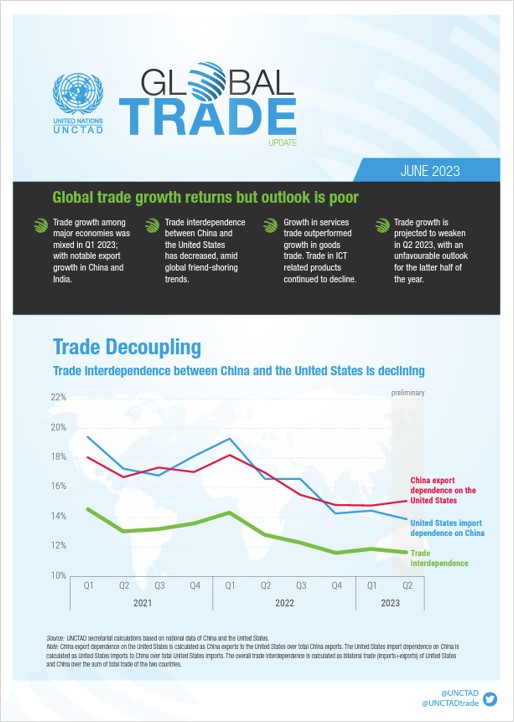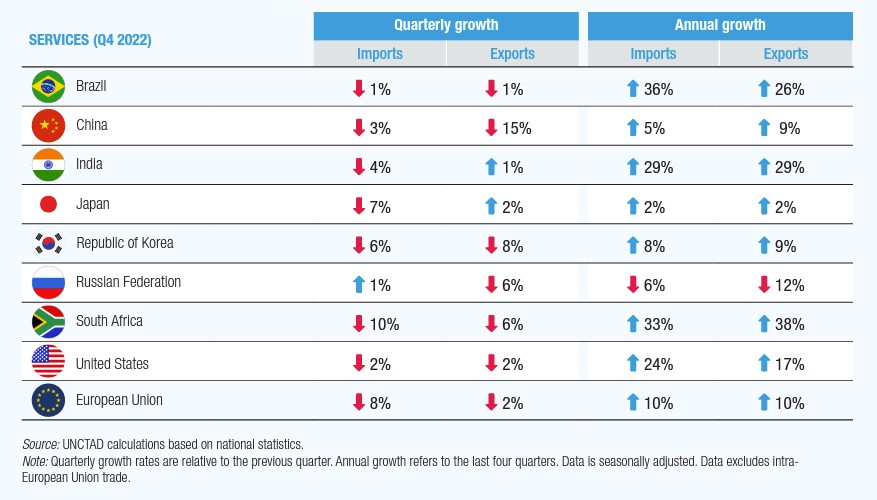How to use it
UNCTAD Global Trade Update
Published 15 August 2023
The United Nations Conference on Trade and Development (UNCTAD) publishes a periodic update providing fundamental data and analysis of current trade flows for goods and services.
Here’s how to use the UNCTAD Global Trade Update.
Why is the UNCTAD Global Trade Update important?
Trade flows are a useful indicator of the state of the global economy. The UNCTAD Global Trade Update provides a brief, easy to digest snapshot of the state of global trade, covering trade flows for both goods and services, trade trends regionally and globally, the key factors affecting trade, and the prospects for trade in the coming quarters.
What’s in the UNCTAD Global Trade Update?
The UNCTAD Global Trade Update includes six sections: global trade trends and nowcast; summary and outlook; trade trends in the major economies; regional trade trends in the first quarter (Q1) of 2023; global trade dynamics and trade dependence; and global trade trends at the sectoral level in Q1 2023.
Global trade trends and nowcast
- Trade growth (values and volumes) was positive but low in Q1 2023 with trade in goods and services rebounding from the second half (2H) of 2022, and notable export growth in China and India; trade interdependence between China and the US has decreased. (pp. 1-3)
- Growth in services trade outperformed goods trade; trade in information and communications technology (ICT) products declined. (p. 1-2)
- Trade growth is likely to weaken in Q2 2023 with an unfavorable outlook for 2H 2023. (pp. 1-3)
Summary and outlook
- Positive factors affecting trade include 1) increasing demand for services; 2) trade supporting the green transition; and 3) low shipping costs. (p. 3)
- Negative factors affecting trade include 1) geopolitics; 2) weakening global economy; 3) potential rise in trade restrictions; 4) slowing industrial output; 5) inflation, commodity prices and interest rates; and 6) concerns over debt sustainability. (p. 3)
Trade trends in the major economies
- Annually, growth in goods trade has been mixed among major economies, with Brazil, India, the US and the EU seeing significant increases but other major economies seeing mixed or negative growth; trade trends in Q1 2023 have been more subdued and even negative. (p. 4)
- Trade in services during 2022 was higher, though quarterly growth rates from Q4 2022 indicate that positive trends are turning negative. (p. 4)
Regional trade trends in Q1 2023
- Annual global trade growth has been positive across all regions except Russia and Central Asia, though East Asian trade is significantly below average; Q1 2023 saw a decline or only marginal growth in trade across all regions; Q1 2023 intraregional trade growth in Africa showed a three percent increase, more than other regions. (p. 5)
Global trade dynamics and trade dependence
- During 2022 and Q1 2023, geographical proximity of trade flows remained stable, while political proximity of trade has increased, indicating lack of nearshoring but an increase in friendshoring, with heightened concentration of major trade relationships. (p. 6)
- Brexit, US-China decoupling, and the Ukraine war have significantly shaped trade trends. (p. 6)
Global trade trends at the sectoral level in Q1 2023
- In 2022, rising energy prices drove higher trade values, with agri-food, apparel, chemicals, and road vehicles increasing and ICT and transportation seeing declines; Q1 2023 saw a decline in the energy sector and a continued downturn for ICT equipment but increases in metals, chemicals, minerals, pharmaceuticals, and motor vehicles trade on a quarterly basis. (p. 7)
How to apply the insights
-
The UNCTAD Global Trade Update uses key data points to explain clearly the state of trade globally, regionally, and in significant industrial sectors. The latest update demonstrates a rebound in trade in 2022 but weakening in early 2023 that will likely continue through the year.
-
The update also interestingly provides evidence of the impact of geopolitical shifts on trade flows. This is an important update for anyone seeking to grasp the state of trade flows and the reasons underlying them quickly and easily.
Complementary reports and analysis
Hinrich Foundation
External Resources
- World Economic Outlook: A Rocky Recovery – International Monetary Fund
The IMF alerts the world to the downsides of friend-shoring and increasing geoeconomic fragmentation. - Challenges to international trade and the global economy – OECD
An assessment of the impact of the war in Ukraine and the Covid pandemic on international trade and supply chains. - Asian Economic Integration Report 2023: Trade, Investment, and Climate Change in Asia and the Pacific – Asian Development Bank
An outline of the economic and environmental challenges Asia currently faces.
© The Hinrich Foundation. See our website Terms and conditions for our copyright and reprint policy. All statements of fact and the views, conclusions and recommendations expressed in this publication are the sole responsibility of the author(s).




